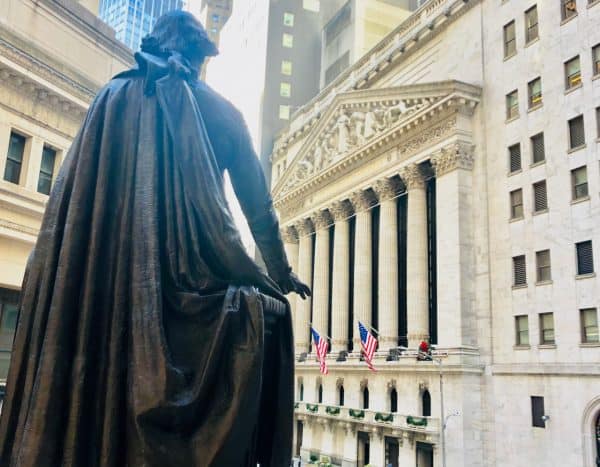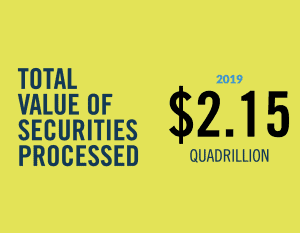
The Depository Trust & Clearing Corporation (DTCC) is an enormous operation providing the vast majority of clearing and settlement services for securities in the US. To put this in perspective, DTCC processed $2.15 quadrillion (a quadrillion is a thousand trillion) in securities during 2019. On a routine day, DTCC is processing trillions of dollars in securities transactions.
For Fintechs and digital innovation, DTCC is a key partner in the transformation process. Speaking at last year’s DTCC Fintech Conference, DTCC CEO Michael C. Bodson, said the potential of distributed ledger technology (DLT) is undeniable, but wondered if its “enormous power to transform financial services will ever be fully harnessed.”
An Inflection Point of Technology
 Explaining that traditional financial firms are facing a serious challenge to the status quo, Bodson said we are at “the start of a great transition for financial services:”
Explaining that traditional financial firms are facing a serious challenge to the status quo, Bodson said we are at “the start of a great transition for financial services:”
“It’s the dawn of a new technology revolution in which the emergence of digital platforms, the rise of APIs, an oncoming generational shift and advances in organizing “data under management” are transforming expectations, reordering priorities and altering the complexion of the industry.”
The mantra of innovate of die holds true for even the most vital type of financial service. DTCC is aware of this fact that change is the only constant and that waiting and watching is not necessarily the best strategy.
In May, DTCC said it was exploring the benefits of digitalization in the public and private markets. DTCC said it is looking to leverage blockchain or distributed ledger technology (DLT) to possibly “strengthen post-trade processes and reduce risks and costs.” DTCC’s initiatives are contained in two case studies: Project Ion and Project Whitney.
Just this week, a new digital asset association was announced to help standardize tokenization – a pressing need. The InterWork Alliance (IWA), a non-profit establishing a standards framework for the tokenization of assets, said that digital assets have the potential to “disrupt global economics.” DTCC is a founding member of IWA, alongside many other prominent organizations. DTCC representative Stephen Scharf said they were proud to work with the Alliance to help develop a “DLT security framework.”
“This important effort will create a critical foundation that will help to increase the safety and security of DLT implementations,” said Scharf.
So DTCC is focusing considerable energy on the possibility of a DLT (or blockchain) augmented future for securities transfers. Recently, Crowdfund Insider reached out to DTCC’s Managing Director, Business Innovation Jennifer Peve to better understand the vision of the company’s future. Beyond her responsibilities at DTCC, Peve also is part of the Technology Advisory Committee of the U.S. CFTC as well as FINRA’s Fintech Industry Committee. She is also the former Chair of the Enterprise Ethereum Alliance (EEA)’s Banking Working Group and a member of SIFMA’s Blockchain Roundtable. So clearly Peve has a broad understanding of the emerging DLT ecosystem.
Our discussion is shared below.
The announcement recently that DTCC was pushing forward on more experimentation with DLT is pretty big news. It was not that long ago that DTCC was pretty skeptical of DLT’s ability to handle its services. What has changed?
 Jennifer Peve: DTCC been exploring the potential benefits of DLT since the early days of the technology and believes in its potential to transform financial services and other industries. However, as with any new technology, there were concerns about unproven and untested areas, such as scalability and security. As a result, we’ve taken a deliberate, measured approach in identifying where DLT might best fit within our infrastructure and our services, an approach based upon research, testing, industry engagement, and real-world use cases.
Jennifer Peve: DTCC been exploring the potential benefits of DLT since the early days of the technology and believes in its potential to transform financial services and other industries. However, as with any new technology, there were concerns about unproven and untested areas, such as scalability and security. As a result, we’ve taken a deliberate, measured approach in identifying where DLT might best fit within our infrastructure and our services, an approach based upon research, testing, industry engagement, and real-world use cases.
Our research indicates that digitalization may be a viable way to drive greater reduction of risk and cost for the industry, regardless of whether it is delivered via DLT or another technology or approach. We look forward to continuing our work around Projects Ion and Whitney.
Can blockchain technology be sufficiently robust to handle the type of transactional demands you require? Which DLTs are you looking at right now?
Jennifer Peve: Project Ion is exploring how we can modernize the backbone of the US capital markets infrastructure by identifying whether the digitalization of assets and the application of DLT can accelerate settlement and reduce cost and risk for the industry. Given the scale and criticality of our services, we undertook a study in 2018 to determine whether DLT might be able to handle the transactional demands of the US equities markets. The study ultimately proved that DLT can support average daily trading volumes in the US equity market of more than 100 million trades per day.
Specifically, DLT performed at levels necessary to process an entire trading day’s volume based on trading activity during a peak time of day of 6,300 trades per second for five continuous hours, which equates to 115,000,000 daily trades. While the results were encouraging, additional pressure testing will need to be done to ensure we can provide the same, if not better, level of service using the technology prior to any production use.
DTCC is currently exploring both private and public DLTs.
What about the “Steampunk Settlement” trap regarding liquidity concerns?
Jennifer Peve: The liquidity trap discussed in the Greenwich Associates white paper had to do with real-time gross settlement on DLT with no intra-day netting. This would require liquidity providers to prefund buys and sells of securities throughout the day even if they would be flat at the end of the day, effectively removing them from the market infrastructure.
The Project ION proof-of-concept uses DLT technology, a technology DTCC has always been a proponent of, to effectuate intra-day netting for one, end of day settlement. In this way, liquidity providers can buy in the morning and sell in the afternoon without pre-funding these trades, preserving the enormous value of intra-day netting. This effectively maximizes liquidity while reducing settlement cycle times which lowers industry risk.
Has there been any discussion regarding the possibility of emerging competition for your services? Or settlement fragmentation?
Jennifer Peve: DTCC is always looking at ways to build upon its current services and provide additional value to our clients, all while prioritizing the resiliency and safety of the financial system.
As part of the Project Ion effort, DTCC is proposing a future vision of an alternative digital settlement service, with the potential to offer the benefits of accelerated settlement, retain the advantages of central netting and prevent fragmentation of the clearing and settlement ecosystem.
DTCC developed a proof of concept to validate the proposed business and operational concepts included in this initiative and is now engaging the industry to assess market demand.
Is DTCC focusing more energy on private markets? And do you think you could get market buy-in for DTCC providing a standard?
Jennifer Peve: DTCC has been offering solutions for the public markets for decades, and we are excited to leverage these learning and capabilities in the private markets. With the private markets, we see a unique opportunity to further automate the space from the ground up – building on our strengths of providing robust and resilient technology that helps drive network effects.
Many private market processes are still manual, and the few digital solutions that are available exist in silos. Project Whitney, the prototype focused on the private markets, is addressing this need and we look forward to advancing the effort.
 What about public markets? It is hard to fathom a transition but obviously you are taking a hard look at this. What are the hurdles?
What about public markets? It is hard to fathom a transition but obviously you are taking a hard look at this. What are the hurdles?
Jennifer Peve: DTCC has been working with the industry to identify new ways to improve and accelerate settlement within the public markets for some time. Over the past few years, these efforts have included partnering with the industry on the U.S. move to T2 in 2017, and creating an accelerated settlement and settlement optimization working group in 2018.
At the same time, we must balance how to leverage new technologies like DLT to drive additional client and business value while preserving the safety and soundness of the system. This requires working closely with our clients and the industry to identify the best way forward.
Predictions in the blockchain sector tend to move at warp speed with reality being left behind in the dust. Realistically, how many years away is a DLT powered DTCC? First private markets and then public. Right?
Jennifer Peve: Both Project Ion and Project Whitney remain in the experimentation stage, and decisions to progress the projects will be made following further analysis and feedback from the industry.
We are exploring both projects simultaneously. We must first assess industry demand and feedback before we can determine whether to deliver a case for change.
What about feedback from traditional financial services. Is this something they want, or they just want things to work better/faster/less expensive?
Jennifer Peve: We are just beginning our outreach, but client response around both projects has been positive. We look forward to working with our community as we progress these initiatives.

